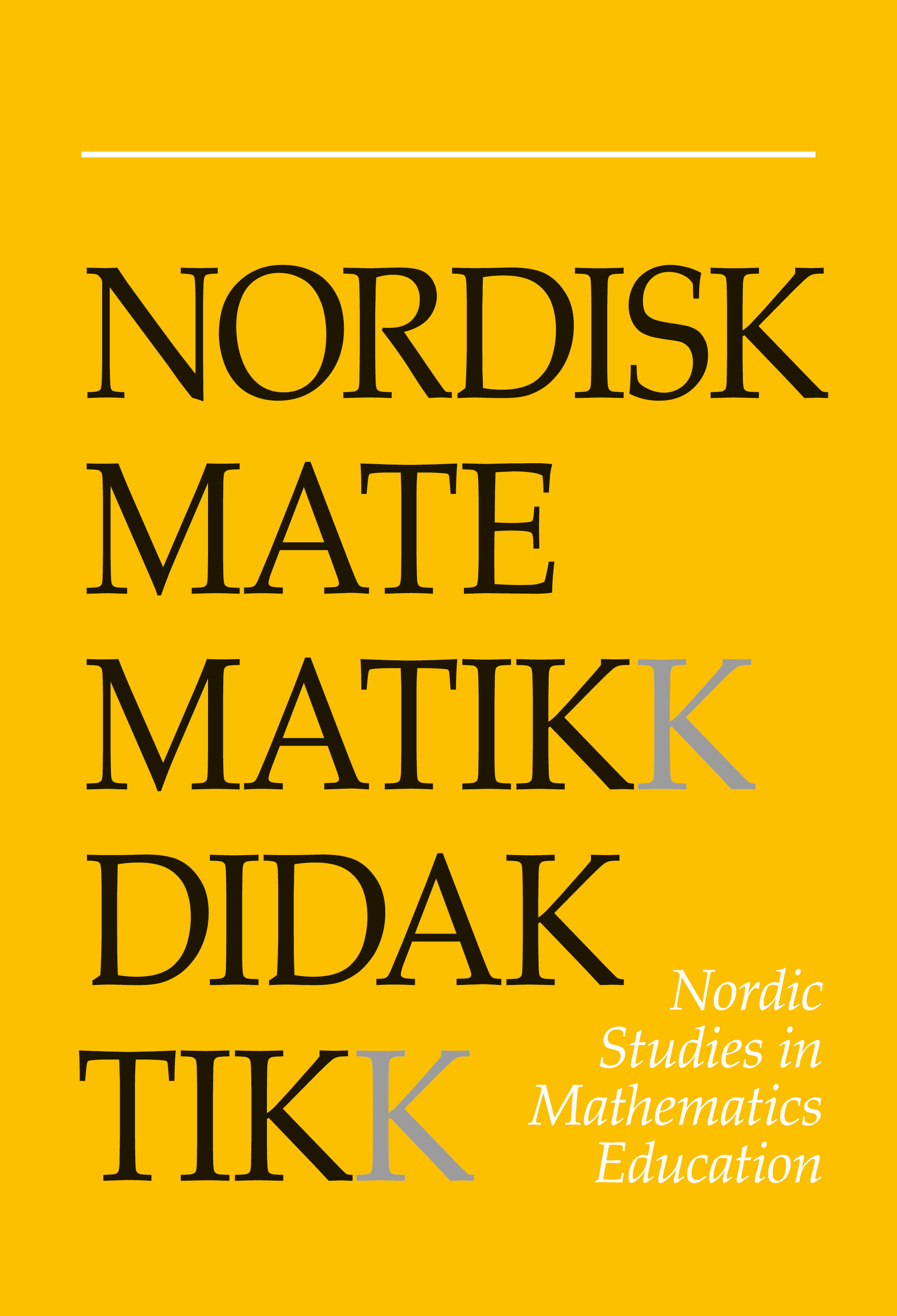The role of textbooks in Finnish upper secondary school mathematics: theory, examples and exercises
DOI:
https://doi.org/10.7146/nomad.v20i3-4.148696Abstract
Textbooks are written mainly for students, but they can also be seen as mediators between the intended curriculum and teachers’ practices. The focus of the present study is on how students and teachers at Finnish upper secondary schools perceive and describe their use of the theory, examples, and exercises presented in their mathematics textbooks. Seventy-one students participated in a short survey, and six of them and three of their teachers were interviewed. The results indicate that the theory, examples, and exercises presented in their textbooks have a strong influence on teachers’ work, but for the students the textbooks primarily represent a source of exercises.
References
Fan, L., Zhu, Y. & Miao, Z. (2013). Textbook research in mathematics education: development status and directions. ZDM Mathematics Education 45, 633-646. https://doi.org/10.1007/s11858-013-0539-x
Galligan, L., Loch, B., McDonald, C. & Taylor, J. A. (2010). The use of tablet and related technologies in mathematics teaching. Australian Senior Mathematics Journal, 24 (1), 38-51.
Gueudet, G. (2008). Investigating the secondary-tertiary transition. Educational Studies in Mathematics, 67, 237-254. https://doi.org/10.1007/s10649-007-9100-6
Haggarty, L. & Pepin, B. (2002). An investigation of mathematics textbooks and their use in English, French and German classrooms: who gets an opportunity to learn what? British Educational Research Journal, 28 (4), 567-590. https://doi.org/10.1080/0141192022000005832
Holmlund, A. (2013). Lärobokens betydelse vid lektionsplanering: en intervjustudie med åtta finska och svenska matematiklärare [The importance of textbook on planning of lessons: an interview study with eight Finnish and Swedish mathematics teachers] [Bachelor's thesis]. University of Gothenburg. Retrieved from http://ncm.gu.se/media/luma/GE-2013/holmlund.pdf
Johansson, M. (2006). Textbooks as instruments. Three teachers' way to organize their mathematics lessons. Nordic Studies in Mathematics Education, 11 (3), 5-30.
Krammer, H. P. M. (1985). The textbook as classroom context variable. Teaching & Teacher Education, 1 (4), 273-278. https://doi.org/10.1016/0742-051X(85)90015-0
Kvale, S. (1996). InterViews - an introduction to qualitative research interviewing. Thousand Oaks: Sage Publications.
Lithner, J. (2008). A research framework for creative and imitative reasoning. Educational Studies in Mathematics 67, 255-276. https://doi.org/10.1007/s10649-007-9104-2
Mikkilä-Erdmann, M., Olkinuora, E. & Mattila, E. (1999). Muuttuneet käsitykset oppimisesta ja opettamisesta − haaste oppikirjoille [Changed conceptions about learning and teaching − a challenge for textbook authors]. Kasvatus, 30 (5), 436-449.
Moore, R. C. (1994). Making the transition to formal proof. Educational Studies in Mathematics, 27, 249-266. https://doi.org/10.1007/BF01273731
Partanen, M. (2013). Lukiolaisten kokemuksia ja näkemyksiä pitkän matematiikan oppikirjan käytöstä [Upper secondary students' experiences and views concerning the use of mathematics textbooks] (Master thesis). Department of Physics and Mathematics, University of Eastern Finland.
Perkkilä, P. (2001). Oppikirja ja uskomukset alkuopettajien matematiikan opetuksessa [Textbook and beliefs in teaching first- and second-grade mathematics]. In A. Ahtineva (Ed.), Tutkimus kouluopetuksen kehittämisessä [Research in the development of school teaching] (pp. 112-125) (Publications of the Faculty of Education: 17). University of Turku.
Piiroinen, J. (2013). Lukion pitkän matematiikan opettajien näkemyksiä oppikirjan käytöstä opetuksessa [Upper secondary teachers' views about the use of textbooks in teaching] (Master thesis). Department of Physics and Mathematics, University of Eastern Finland.
Remillard, J. T. & Bryans, M. T. (2004). Teachers' orientations toward mathematics curriculum materials: implications for teacher learning. Journal for Research in Mathematics Education, 35 (5), 352-388. https://doi.org/10.2307/30034820
Valverde, G. A., Bianchi, L. J., Wolfe, R. G., Schmidt, W. H. & Houang, R. T. (2002). According to the book: using TIMSS to investigate the translation of policy into practice through the world of textbooks. Dordrecht: Kluwer. https://doi.org/10.1007/978-94-007-0844-0
Viholainen, A., Asikainen, M. & Hirvonen, P. (2014). Mathematics student teachers' epistemological beliefs about the nature of mathematics and the goals of mathematics teaching and learning in the beginning of their studies. Eurasia Journal of Mathematics, Science & Technology Education, 10 (2), 159-171. https://doi.org/10.12973/eurasia.2014.1028a
Österholm, M. (2006). Characterizing reading comprehension of mathematical texts. Educational Studies in Mathematics, 63 (3), 325-346. https://doi.org/10.1007/s10649-005-9016-y
Downloads
Published
How to Cite
Issue
Section
License

This work is licensed under a Creative Commons Attribution-NonCommercial-ShareAlike 4.0 International License.



